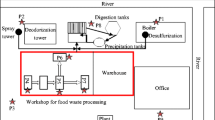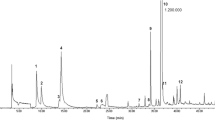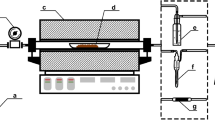Abstract
Offensive odorant emissions from a food waste (FW) treatment plant that uses hydrothermal hydrolysis and aerobic fermentation technology were studied for 1 month through in situ monitoring and laboratory testing. Results showed that the emission flux (7000 μg kg−1FW h−1) of total volatile organic compounds and concentrations of most volatile organic compounds (VOCs) were highest at the discharge outlet of the hydrothermal hydrolysis reactor. Furthermore, VOC composition analysis showed that the concentrations of most hydrocarbons detected during the sorting/crushing process were higher than those in the aerobic fermentation process, but more oxygenated organic compounds and pinenes were released in the aerobic treatment process. The analysis of VOC temporal characteristics via t test indicated that even with various FW loads during the day and night, most VOC concentrations sampled in the storing room were not significantly different. However, great variances among most VOC concentrations were observed during the sorting/crushing process and at the hydrothermal hydrolysis reactor. The annoyance degrees of offensive gases were also determined via analysis of odor indices. The results suggested that sulfocompounds mainly dominated in terms of high odor activate values during the sorting/crushing process, and the fractional content of oxygenated organic compounds increased in the aerobic treatment processes.




Similar content being viewed by others
References
Schneider F (2013) The evolution of food donation with respect to waste prevention. Waste Manag 33(3):755–763
Pierucci P, Porazzi E, Martinez MP, Adani F, Carati C, Rubino FM, Colombi A, Calcaterra E, Benfenati E (2005) Volatile organic compounds produced during the aerobic biological processing of municipal solid waste in a pilot plant. Chemosphere 59(3):423–430
Sundberg C, Yu D, Franke-Whittle I, Kauppi S, Smårs S, Insam H, Romantschuk M, Jönsson H (2013) Effects of pH and microbial composition on odour in food waste composting. Waste Manag 33(1):204–211
Büyüksönmez F (2012) Full-scale VOC emissions from green and food waste windrow composting. Compost Sci Util 20(1):57–62
Kim KH, Pal R, Ahn JW, Kim YH (2009) Food decay and offensive odorants: a comparative analysis among three types of food. Waste Manag 29(4):1265–1273
Zou SC, Lee SC, Chan CY, Ho KF, Wang XM, Chan LY, Zhang ZX (2003) Characterization of ambient volatile organic compounds at a landfill site in Guangzhou, South China. Chemosphere 51(9):1015–1022
Font X, Artola A, Sanchez A (2011) Detection, composition and treatment of volatile organic compounds from waste treatment plant. Sensors 11(4):4043–4059
Kim KH, Choi YJ, Jeon EC, Sunwoo Y (2005) Characterization of malodorous sulfur compounds in landfill gas. Atmos Environ 39(6):1103–1112
Kim KH (2006) Emissions of reduced sulfur compounds (RSC) as a landfill gas (LFG): a comparative study of young and old landfill facilities. Atmos Environ 40(34):6567–6578
Escalas A, Guadayol JM, Cortina M, Rivera J, Caixach J (2003) Time and space patterns of volatile organic compounds in a sewage treatment plant. Water Res 37(16):3913–3920
Yue DB, Han B, Sun Y, Yang T (2014) Sulfide emissions from different areas of a municipal solid waste landfill in China. Waste Manage 34(6):1041–1044
Fang JJ, Yang N, Cen DY, Shao LM, He PJ (2012) Odor compounds from different sources of landfill: characterization and source identification. Waste Manag 32(7):1401–1410
Li JJ, Wu YD, Zhang YL, Zeng PY, Tu X, Xu MY, Sun GP (2015) Emission of odorous volatile organic compounds from a municipal manure treatment plant and their removal using a biotrickling filter. Envrion Technol 36(8):1050–1056
Zhang L, Lee YW, Jahng D (2011) Anaerobic co-digestion of food waste and piggery wastewater: focusing on the role of trace elements. Bioresour Technol 102(8):5048–5059
Liu JG, Wang XW, Nie XQ, Li RD, Song MY (2013) In-situ emission characteristics of odorous gases from two food waste processing plants. J Mater Cycles Waste Manage 15(4):510–515
Wang XM, Wu T (2008) Release of isoprene and monoterpenes during the aerobic decomposition of orange wastes from laboratory incubation experiments. Environ Sci Technol 42(9):3265–3270
Wu T, Wang XM (2012) Release of volatile organic compounds from food waste during the aerobic decomposition. Acta Sci Circumst 32(10):2575–2583
Mao IF, Tsai CJ, Shen SH, Lin TF, Chen WK, Chen ML (2006) Critical components of odors in evaluating the performance of food waste composting plants. Sci Total Environ 370(2–3):323–329
Sarkar N, Ghosh SK, Bannerjee S, Aikat K (2012) Bioethanol production from agricultural wastes: an overview. Renew Energy 37(1):19–27
Prasad S, Singh A, Joshi HC (2007) Ethanol as an alternative fuel from agriculture, industrial and urban residue. Resour Conserv Recycl 50:1–39
Ma HZ, Wang QH, Qian DY, Gong LJ, Zhang WY (2009) The utilization of acid-tolerant bacteria on ethanol production from kitchen garbage. Renew Energy 34(6):1466–1470
Hatfield JL, Smith DD (2013) Food and agricultural waste: sources of carbon for ethanol production. Carbon Manag 4(2):203–213
Feilberg A, Liu D, Adamsen APS, Hansen MJ, Jonassen KEN (2010) Odorant emissions from intensive pig production measured by online proton-transfer-reaction mass spectrometry. Environ Sci Technol 44(15):5894–5900
Lee HD, Jeon SB, Choi WJ, Lee SS, Lee MH, Oh KJ (2013) A novel assessment of odor sources using instrumental analysis combined with resident monitoring records for an industrial area in Korea. Atmos Environ 74:277–290
Nagata Y (2003) Odor intensity and odor threshold value. Bulletin of Japan, Environmental Sanitation Center, Kawasaki, pp 17–25
Rosenfeld PE, Clark JJJ, Hensley AR, Suffet IH (2007) The use of an odour wheel classification for the evaluation of human health risk criteria for compost facilities. Water Sci Technol 55:345–357
He PJ, Zeng Y, Tang JF, Shao LM (2010) Emission of volatile organic compounds during initial decomposition phase of municipal solid waste. J Tongji Univ (Nat Sci) 38(6):854–869
Wu T, Wang XM, Li DJ, Yi ZG (2010) Emission of volatile sulfur compounds (VOSCs) during aerobic decomposition of food waste. Atmos Environ 44(39):5065–5071
Acknowledgments
The project is supported by the Environmental Protection Public Welfare Project (grant number 201109035).
Author information
Authors and Affiliations
Corresponding author
Rights and permissions
About this article
Cite this article
Kong, X., Liu, J., Song, M. et al. Spatial and temporal variability of odorous VOC in a food waste treatment plant using hydrothermal hydrolysis and aerobic fermentation technology. J Mater Cycles Waste Manag 17, 626–636 (2015). https://doi.org/10.1007/s10163-015-0407-6
Received:
Accepted:
Published:
Issue Date:
DOI: https://doi.org/10.1007/s10163-015-0407-6




